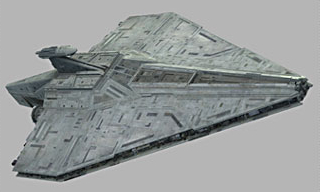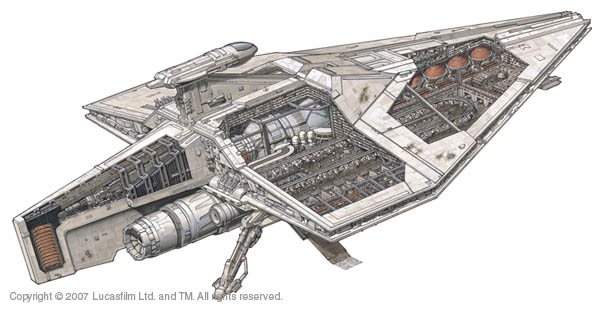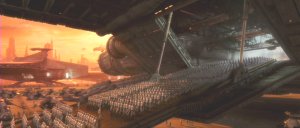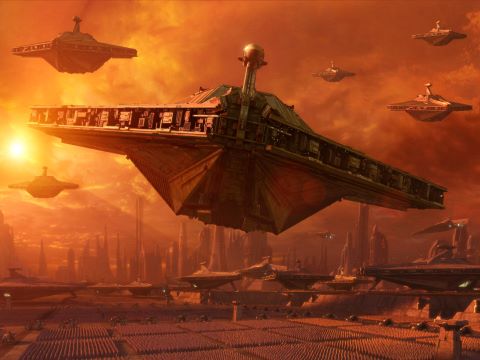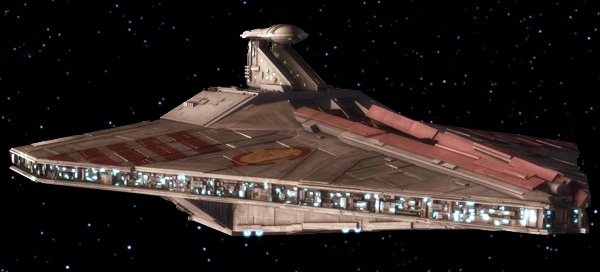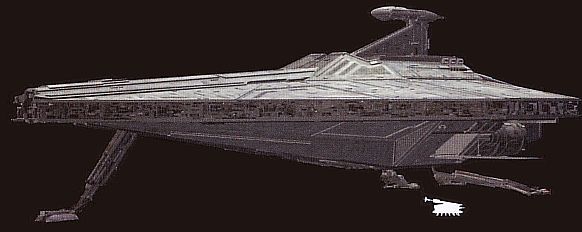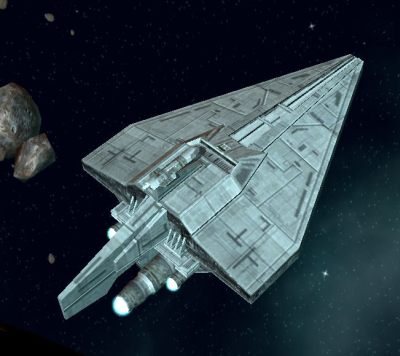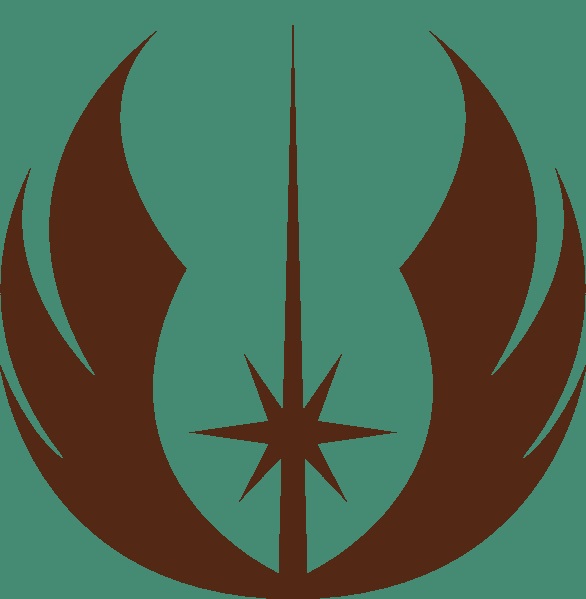

| "Master SIFO-DYAS requested the most powerful army in the galaxy. We have worked with only the best shipbuilders to fulfill that request." - Lama SU |
The ACCLAMATOR-Class Assault Ship, also known as the Republic assault ship, ACCLAMATOR-Class Star Destroyer, or ACCLAMATOR-Class medium frigate, was a starship created for the Galactic Republic by Rothana Heavy Engineering. It was the predecessor of the Star Destroyer line.
Characteristics
Dimensions
The 2,468 foot long ACCLAMATOR-Class assault transport carried thousands of Republic clone troopers into battle. The ACCLAMATOR favored a wedge or dagger shaped design, like the Republic warships during the Mandalorian Wars, due to its effectiveness- It allowed concentration of firepower while minimizing target profile. This basic design was used in a number of larger craft predating it and would define Imperial ships for decades to come.
Offensive and defensive systems
These ships were armed with 4 heavy torpedo launch tubes; 24 point-defense laser cannons, rated at 6 megatons per shot; and 12 quad turbolaser turrets, each rated at a maximum of 200 gigatons per shot.
Groups of these ships could perform a "Base Delta Zero," an orbital bombardment that would exterminate all life on the planet. The later ACCLAMATOR-Class could also serve as star frigates to support their landing groups. In addition to ground landings, ACCLAMATOR-Class ships were capable of water landings, as displayed at the Battle of Mon Calamari.
The sensor and communications suites were located at the front of the ship's command tower.
The hull armor of ACCLAMATOR-Class vessels was impregnated with ultra-dispersive neutronium that withstood and spread massive energy blasts. Fusion rockets fired by enemy forces barely made a scratch on the hull as a result.
Complement
ACCLAMATOR-Class ships also carried support equipment and vehicles, such as the AT-TE and SPHA-T walkers, used to provide clone troopers with heavy battlefield support.
Each ACCLAMATOR-Class ship held 320 speeder bikes, used by clone troopers for fast battlefield reconnaissance and patrol duties. Eighty LAAT gunships were carried to insert personnel, vehicles, and cargo into battle zones in addition to providing close air support.
Gunships were suspended along an overhead circulating rail in the upper hangar for maintenance procedures during travels. A lower, smaller hangar area was used to embark and disembark ground troops and material when landed. The two levels were connected with elevator platforms. Most of the passenger and barrack decks were located on the upper levels of an ACCLAMATOR-Class ship.
Propulsion Systems
The ACCLAMATOR-Class' main reactor was located in the middle of the vessel, inside the main superstructure, and was preceded at the frontal half of the ship by multiple fuel tanks. The tanks compressed hypermatter to enormous density for storage. The tanks were connected to the main reactor via pipe assemblies. Secondary reactors were located towards the bow of the vessel.
The ship's main thrusters were fitted with eight electromagnetic rudders that deflected the exhaust particle streams and gave boost when turning the ship. The secondary thrusters did not provide as much power, but were useful for maneuvering due to being placed further away from the ship's main axis.
The massive fin at the stern of the ACCLAMATOR-Class contained both the anti-gravity generator and the ship's hyperdrive generator. When landed, the repulsorlift carried much of the ship's weight, but the landing legs maintained a stable contact with the ground.
Bridge
The bridge was located in the middle of an arrow-shaped command tower module that protruded from the dorsal superstructure. This tower module was a standard design for smaller ships in Kuat Drive Yards's starship catalog, which Rothana supplied vessels to. The main bridge and command center had no windows but relied upon advanced holoscreens shaped like the triangular viewports similar to the ones on other Kuat vessels. The bridge crew usually consisted of fully-armored clone pilots manning the control panels, with most operators being seated in twin crew pits below the command officer's area.
History
Pre-war Origins
The design was seen as early as 32 BBY, shortly after the resolution of the Invasion of Naboo, in an important system performing fleet-maneuvers with other capital ships. These vessels had some differences from the ship that would become famous during the Clone Wars, but the similarities were present in this and at least one other ship-design.
Republic Use
As the Jedi Master Yoda arrived on Kamino to gather an invasion force, dozens of ACCLAMATORS had already been built and readied for the soldiers they were designed to carry. In their first engagement at the Battle of Geonosis, the class proved pivotal in the Republic victory, delivering legions of clone troopers to the battlefield while a large Republic fleet engaged the Separatist fleet in orbit. After delivering their troops, the ACCLAMATORS pulled back to provide orbital support, with only a portion of the ships ending up damaged in the battle.
Several different variations were used during the war, with the ACCLAMATORI-Class assault ship being the most numerous alternate model. The subclasses saw many battles in both the Clone Wars and the Galactic Civil War. Other Kuati designs complemented and supplanted the ACCLAMATOR-Class, but the design was popular enough to continue service for decades.
Later Service
Several variants of the ACCLAMATOR design appeared to be dedicated for space combat rather than planetary assault. Its design was also influential on the development of several other warships. One example was the Class II Frigate, represented by Rand Ecliptic, which had a more narrow hullform and two docking bays with port and starboard openings. There was no large downward-facing hangar bay as seen on some of the early ACCLAMATOR-Class ships, but there were large retractable loading ramps in order for the clone troopers to board.
In addition to being a warship and a militry transport serving forces in backwater areas, some Imperial ACCLAMATORS were used as slave ships, transporting large quantities of enslaved people to various Imperial penal colonies during the Galactic Civil War. Although they were initially not considered "Star Destroyers", the ACCLAMATOR-Class was sometimes referred to as such during the reign of the Empire.
Some fell into the hands of criminal groups such as the Zann Consortium. The Empire continued to use them as of Operation Shadow Hand, and they were even used well into the Yuuzhan Vong War and Second Galactic Civil War, though they were only shadows of their former glory.
They were primarily used by the old Republic during the closing phases of the Clone Wars, but it also served the Galactic Empire during the Galactic Civil War and often being used to reinforce the defense of various space stations. At least two were also used by the New Republic at the Battle of Mindor.
Current Service
Since the United Galaxies Council's annexation of Galaxy, several firms have begun producing the ACCLAMATOR-Class for private militry contractors and the pirates they normally are hired to protect fleets against. This is interesting, because only a half-dozen of these ships still existed at that time (2 of them were derelicts, one in the hands of the Geh 'Dai, one being used as a freighter, and the other two as part of the Gennin System's defenses; all six are accounted for).
The Geh 'Dia Order recently began producing these ships as a response, selling them primarily to various systems who occasionally lease them to the PMC's as part of a contract. None of these have fallen into pirate control.
Currently there are 03 ACCLAMATOR-Class Assault Ships in formal UGC service, UGS CORUSCANT and FANTOMA, for research, development, and testing. They are not currently expected to be accepted into general service, however, RDF's are at their leisure to accept them for internal use.
The Aero-Space Forces have requested 02 ships in the orbital bombardment configuration for testing and evaluation as a replacement for the B-104 Galaxy Strategic Bomber, but the UGC has not approved this plan. Under the ASF's plan, the ships in question will be configured as interceptor carrier/bombers for support for Spacy fleets. This plan will eventually be approved however, with a fleet of around 144 ships each carrying one Aero-Space Force (144 fighters or 72 bombers, or a combination thereof), a few dozen L-35 Rail Launchers, and over 5,000 warheads.
ACCLAMATOR II (ACCLAMATOR SLEP)
The so-called ACCLAMATOR II were ACCLAMATORS that were subjected to an extensive Service Life Extension Program to make them compatible for planetary bombardment, thus converting them from basic transports into full-fledged warships. As a result of this, ships of this class had 80% less space available for troops; Therefore, only about 10% were so converted, and only one or two sailed with any given fleet for orbital strikes while the majority of a given planetary assault fleet would be made up of the troop carrying class.
The heavy proton torpedo launchers used were earlier models of those of the later designed Torpedo Spheres. They were designed to breach planetary shields but could also target other capital ships.
Vehicle Type: Aero-Space Fighter/Attacker/Tactical Reconnaissance.
Crew: One or two.
M.D.C By Location:
Tower-
800
Main Launch Ramps (2, 1 bow 1 stern)-
800
Speed and Statistical Data:
Hyperdrive: 0.75
In Atmosphere and Space: 746 mile/hour.
Maximum Range: 500,000 light years (about 2,000,000,000,000,000,000 miles). The craft can NOT be refueled in flight.
Length: 2,467 feet 2.3 inches.
Width: 1,509 feet 2 inch.
Height: 656 feet 2 inches (200m) with landing struts, 600 feet 9 inches (183m) in flight.
Power System: Fusion power supply with a 15 year duration at normal output.
Flight System: Anti-Gravity Pods.
Cargo: 7,062,934 foot3 excluding hangar space and consumables storage (12,401.002248 tons) Orbital Bombardment Variant: 11023.113109 tons.
Cost and Availability: 250 millioncredit and 3 months to build; Takes anoth 10 millioncredit and 2 weeks to convert to a bombardment version.
Purpose: Anti-Ship Assault.
MD: 1D4 times 50 per blast.
Rate of Fire: Cycles four times per melee.
Range: 200 miles.
Payload: Unlimited.
2. Point-Defense Laser Cannons (24): A light laser cannon used on capital ships that are meant to defend against starfighter and missile assaults, although it is often used in ship to ship combat as well.
Purpose: Anti-Fighter/Missile Defense.
MD: 5D6 per blast.
Rate of Fire: Per gunners attacks per melee plus bonuses (generally 4 or 5 per melee).
Range: 500 feet.
Payload: Unlimited.
Purpose: .
MD and Range: .
Rate of Fire: .
Payload: 100 Torpedos.
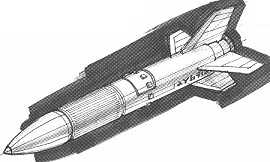
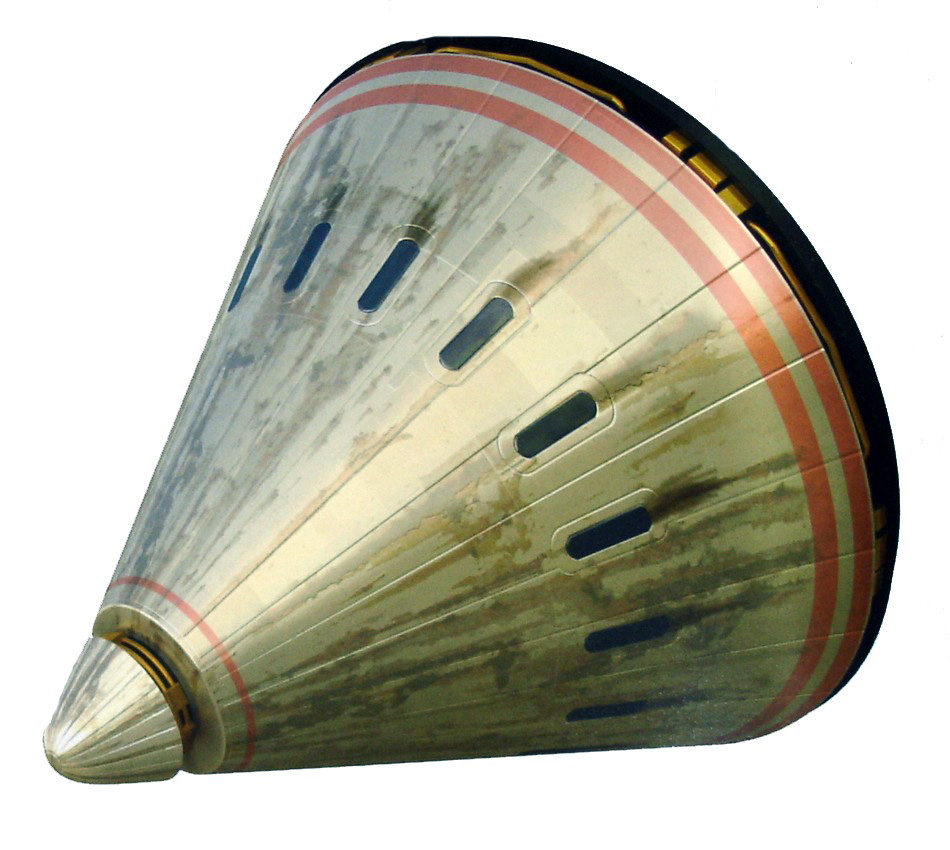 4. MG7-A Heavy Proton Torpedo Launchers (2): Exactly like a normal proton torpedo, but generally can only be used on a capital ship or as a pylon-mounted weap on single units. The MG7-A is currently the heaviest in production, and can only be utilized on capital ships (would qualify as a small fighter if it had a cockpit).
4. MG7-A Heavy Proton Torpedo Launchers (2): Exactly like a normal proton torpedo, but generally can only be used on a capital ship or as a pylon-mounted weap on single units. The MG7-A is currently the heaviest in production, and can only be utilized on capital ships (would qualify as a small fighter if it had a cockpit).Purpose: Orbital Bombardment.
MD and Range: .
Rate of Fire: .
Payload: 100 torpedos.
Cost and Availability: As high as a half million or as low as 10,000 credits each; Pretty common in certain systems, utterly rare in others.
The UGC's main orbital bombardment variant is armed with a dozen L-35 Rail Launchers aimed slightly outboard and forward; Assuming the Captain and crew calculate their height and speed correctly (which is made much easier by the onboard computers), the ship will pass over the target zone with just enough time to be outside of any potential blast area.
In an orbital bombardment variant the turbolasers are used to pick off targets too unimportant to waste a warhead on but too important to ignore (factories outside of cities, aerospace fields, etc.).
In general the UGC disdains turbolasers since REF designed weapons are much more efficient in this regard, but the Council accepted the weapons as part of a diplomatic effort with the Rakatan Galaxy's various member states. The REF has been quietly switching out turbolasers for T'sentraedi Heavy Energy turrets as soon as the turbolasers need replacing (or when the Captain can claim they needed to).
Purpose: Anti-Ship Assault/Secondary Orbital Bombardment.
MD: 1D6 times 10 per blast.
Rate of Fire: Cycles four times per melee.
Range: 200 miles.
- E.S.M.: Radar Detector. Passively detects other radars being operated.
- Radar: Combat grade radar. Range 100 miles, can track up to 50 individual targets. 95% reliability (24% against unfriendly stealthed vehicles).
- Blue Force Tracker: Identifies friend from foe. Overlays the information on both the radar and HUD, ensuring that friendly forces are not accidentally targeted.
- GPS: Standard tracking device. Ties into the Blue Force Tracker.
- Anti-Jamming System: Reduces Electronics Countermeasure by 3/4 (decrease skill level appropriately).
- HUD: Displays maps, radar, targeting information, and any OTHER information the wearer wants directly in front of the user.
- FLIR/SLIR: Forward and Side Looking Infrared. Allows pilot to get visuals on targets at night.
- AJP: Active Jamming Pod. Causes -25% to detection but when it is active, other vehicles/bases can detect that it is jamming, and some missiles will home in on jamming signals. Jamming also causes a -4 penalty to all radar guided weapons. The jamming pod is only mounted inside the port taileron.
- Oxygen Rebreather System: Extends pilots air supply to 100 hours; Cartridge MUST be replaced after that period of time.
- Magnetic Clamps: Electro magnets in the pads of the landing struts allow the fighter to adhere to the hulls of warships and the exteriors of SOME buildings.
- Combat/Targeting Computer: Records all enemy and friendly activity over the course of time; Can replay that activity for the pilot, assign target designation numbers, and track likely damage based on mathematical formulas (i.e. "Port Quarter Hull" badly damaged/destroyed, "Main Sensor Array" not damaged, etc). Displays this information as a pop up in the HUD on request by the crew anywhere on board.
- MRA 6 Radios: Allows real time, continuous radio link up with friendly forces in the area via satellite relay over laser radio signals, preventing jamming, and automatically encrypts/decrypts same to prevent eavesdropping.
- Type-11 wide band radios: Effective 10 mile range, auto encrypt/decrypt. Works on standard radio band wavelengths, so it can still be jammed (if the enemy knows the frequencies).
- Full Range Sensory Systems: Infrared, Ultra Violet, Color Filters, and Thermal Imager: Range: 10 miles; Magnification: 40 times
- Virtual Map: Displays a continuously-updating map of local terrain for the pilot. Takes data from other friendly units in the area. Effective land navigation of 85% as updates come. Good to 500 miles. Specific range can be adjusted in 100 mile increments.
- Video Camera: Records from the HUD and Hdd. 50 hours of recording available.
- Towed XTNDR RADAR/Radio Antenna Extender: A simple 10 lb. pod is towed 100 feet behind the fighter. A fiber-optic cable relays the data collected from the XTNDR Pod to the fighter's computers.
M.D.C. By Location:
Pod: 50
Fiber Optic Cable: 10
Effect: Extends range of any sensors 10 times (or defeats other penalties in a 5 mile area). - Decoys: Despite the relative commonality of the Launched/Towed Decoy Pods and Anti-Missile Chaff/Flare Dispenser systems, the simpler Decoys originally used on the Starfighter is the one still in use. The reason they have not been switched out for the more effective L/TDP and AMC/FD systems is the Steinerian sense of superiority; However, privately owned combat ready craft have been retro-fitted to the better system. The decoys themselves are specially modified Mini-Missiles that produce burning globs of magnesium/aluminum alloy to confuse both radar AND heat sensory systems, as well as creating a lot of smoke to obscure the fighter. Note: Though the modified mini-missiles combine smoke flares, AMC/FDs, and LDP's, they aren't powerful enough for use with Destroids/Guardians/Etc. Reduce effects by 20% against smart missiles (add +20% to rolls for smart missiles).
Effect:
01-50: Enemy missile or missile volley detonates in chaff cloud-
Missiles are all destroyed.
51-75: Enemy missile or missile volley loses track of real target and veers away in wrong direction (may lock onto another target).
76-00: No effect, missile is still on target.
Also note that the chaff cloud will also blind nearby heat sensors (and optically based sensors at night) for 1 melee. They will suffer the following penalties: Reduce melee attacks/actions, and combat bonuses by half. Also, a cloud of smoke approximately 252'.
Duration: 1D4 melee rounds.
Rate of Fire: Once per melee.
Payload: 6 chaff/flares. - Survival Pack: A pack of simpler emergency survival supplies.
- Combat Bonuses from ACCLAMATOR-Class Assault Ship Combat Elite:
- 1 additional attack per melee.
- One additional attack per melee at levels 3 and 6.
- +1 Initiative.
- +1 Strike.
- +1 Dodge.
The UGC approved the acquisition of 100 ACCLAMATOR-Class Assault Ships in the Orbital Bombardment configuration with the following diffrences:
12 B-104 Bombers in Block 1500 configurations
36 RDF/REF VF-19 Excalibur Veritechs
120 ASF-21 Sholagar Fighters
Up to 24 additional aerospace craft (very often at least one U-2 Dragon Lady).
This was significantly heavier than the ASF had proposed, but they quckly began deploying the fleet in support of the rest of the REF.
